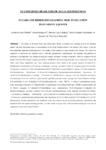Please use this identifier to cite or link to this item:
http://www.alice.cnptia.embrapa.br/alice/handle/doc/16122| Title: | Sugarcane herbicide leaching risk evaluation in Guarany Aquifer. |
| Authors: | PARAIBA, L. C.  KATAGUIRI, K.   CERDEIRA, A. L.   QUEIROZ, S. C. do N. de   FERRACINI, V. L.   |
| Affiliation: | LOURIVAL COSTA PARAIBA, CNPMA; Karen Kataguiri, Estagiária-Embrapa Maio Ambiente; ANTONIO LUIZ CERDEIRA, CNPMA; SONIA CLAUDIA DO N DE QUEIROZ, CNPMA; VERA LUCIA FERRACINI, CNPMA. |
| Date Issued: | 2008 |
| Citation: | In: CONGRESSO BRASILEIRO DE ÁGUAS SUBTERRÂNEAS, 15.; ENCONTRO NACIONAL DE PERFURADORES DE POÇOS, 16., 2008, Natal. Anais... Natal: ABAS, 2008. 6p. CD-ROM. |
| Description: | he region of Ribeirão Preto, São Paulo State, Brazil, is located over recharge area of the Guarany aquifer, the most important source of groundwater in the South Central region of the country. This region is also the most important sugarcane producing area of the country which produces a large amount of the ethanol. This study was conducted to determine the potential risk of herbicide groundwater contamination. The leaching risk potential of herbicides to groundwater was conducted using the weather simulator ?Weather Generator? (WGEN) coupled with the model ?Chemical Movement Trough Layered Soils? (CMLS94). The following herbicides were evaluated in clayey and sandy soils (Typic Haplorthox and Typic Quartzipsamment soils) found in the region: ametryn (N-ethyl-N\'-(1- methylethyl)-6-(methylthio)-1,3,5-triazine-2,4-diamine), atrazine (6-chloro-N-ethyl-N\'-(1-methylethyl)-1,3,5-triazine- 2,4-diamine), clomazone (2-[(2-chlorophenyl)methyl]-4,4-dimethyl-3-isoxazolidinone), diuron (3,4-dichlorophenyl)- N,N-dimethylurea), halosulfuron (3-chloro-5-[(4,6-dimethoxy-2-pyrimidinyl)amino]carbonyl], hexazinone (3- cyclohexyl-6-(dimethylamino)-1-methyl-1,3,5-triazine-2,4 (1H,3H)-dione), imazapic ((±)-2-[4,5-dihydro-4-methyl-4- (1-methylethyl)-5-oxo-1H-imidazol-2-yl]-5-methyl-3-pyridinecarboxylic acid), imazapyr ((±)-2-[4,5-dihydro-4-methyl- 4-(1-methylethyl)-5-oxo-1H-imidazol-2-yl]-3-pyridinecarboxylic acid), MCPA (4-chloro-2-methylphenoxy)acetic acid), metribuzin (4-amino-6-(1,1-dimethylethyl)-3-(methylthio)-1,2,4-triazin-5(4H)-one), MSMA (Amonosodium salt of MAA), paraquat (1,1\'-dimethyl-4,4\'-bipyridinium ion), pendimethalin (N-(1-ethylpropyl)-3,4-dimethyl-2,6- dinitrobenzenamine), picloram (4-amino-3,5,6-trichloro-2-pyridinecarboxylic acid), simazine (6-chloro-N,N\'-diethyl- 1,3,5-triazine-2,4-diamine), sulfentrazone [N-[2,4-dichloro-5-[4-(difluoromethyl)-4,5-dihydro-3-methyl-5-oxo-1H- 1,2,4-triazol-1-yl]phenyl]methanesulfonamide], and tebuthiuron [N-[5-(1,1-dimethylethyl)-1,3,4-thiadiazol-2-yl]-N,N\'- dimethylurea]. Results obtained by our simulation study have shown that the herbicides picloram, tebuthiuron, and metribuzin have the highest leaching potential, in either sandy or clayey soils, with picloram reaching the root zone of sugarcane at 0.6m in less than 150 days. |
| Thesagro: | Herbicida |
| Keywords: | Água subterrânea |
| Type of Material: | Artigo em anais e proceedings |
| Access: | openAccess |
| Appears in Collections: | Artigo em anais de congresso (CNPMA)  |
Files in This Item:
| File | Description | Size | Format | |
|---|---|---|---|---|
| 2008AA100.pdf | 28.87 kB | Adobe PDF |  View/Open |









